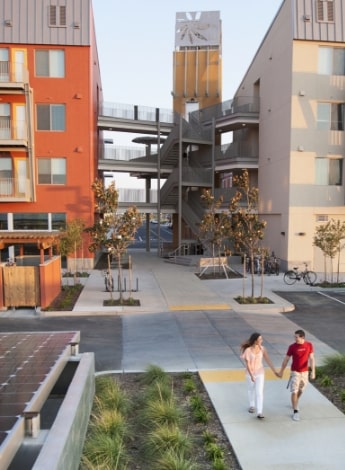
5 facts about ... physiotherapy and climate change

- David Duindam, Deb Sutherland, Jessica Clarke and Professor Gillian Webb present five discussion points about sustainable physiotherapy practice and the role of physiotherapists in climate change advocacy.
1. Preventive health supports environmentally sustainable healthcare

The healthcare sector plays a significant role in Australia’s greenhouse gas emissions, accounting for approximately seven per cent, with notable contributions from hospitals and pharmaceuticals (Malik et al 2018).
Projected future trends—such as population growth, the escalation of chronic diseases and ageing populations—are expected to amplify the demand for healthcare services and to increase resource consumption (McPake & Mahal 2017).
An effective transition towards sustainable healthcare is therefore critical to mitigating climate change, which is itself a significant threat to health (Costello et al 2023, Salas et al 2020).
This requires a multifaceted approach, including strategies to reduce greenhouse gas emissions and preventive health approaches to minimise the demand for healthcare services and associated resource consumption (Salas et al 2020).
Physiotherapists already support preventive health by promoting physically active lifestyles and helping to prevent the onset and progression of disease.
Along with other health professionals, they can play a part in reducing the demand for resource-intensive healthcare (Palstam et al 2022).
2. Clinics can reduce their carbon footprint through evidence-based initiatives

The most efficient way for physiotherapy practices to reduce their carbon footprint is to focus on the following four areas: energy use, waste management, decarbonising the supply chain and staff behaviour change (Salas et el 2020, Duindam 2022).
To reduce energy use, clinics can turn off electronic equipment when not in use, avoid overheating or overcooling premises and reduce emissions due to staff and patient travel by using telehealth where appropriate, incentivising public or active transport options (Karliner et al 2020, My Green Doctor 2021).
They can also change energy retailers to those offering certified carbon offsets or ‘green power’.
Reducing emissions associated with waste management means reducing the number of single-use items used and ensuring that clinics are recycling appropriately.
Meanwhile, approximately 70 per cent of healthcare sector emissions are associated with supply chains (Karliner et al 2020, Malik et el 2018).
To decarbonise its supply chain, a clinic should only use items that are really needed; should source locally made, ecologically superior products made from plastic alternatives; and should pressure suppliers to stock cost-competitive, high-quality items that are not made of or packaged in virgin plastic.
In order to influence positive behaviour change among staff, practice owners and managers can provide education and training in environmental sustainability, especially focusing on the co-benefits to the organisation, the environment and the larger community of adopting sustainability initiatives.
3. Physiotherapists can advocate for sustainability in climate policy

As trusted professionals with a strong level of public confidence, physiotherapists can participate in advocacy for broad sustainability initiatives that will have an impact on the health of patients and communities (Climate and Health Alliance 2021).
This might include making submissions to government at local, state and federal levels on environmental legislation and policy (Kotcher et al 2021).
Another example is supporting new urban development planning and transport infrastructure that encourages active travel (eg, safe bike and walking paths, increased urban green space and higher density housing instead of urban sprawl), which would make it easier for patients to follow a physiotherapist’s prescribed walking program (World Health Organization 2021, Duindam 2022).
Advocating to state and federal health departments for improved public access to and funding of high-value, evidence-based healthcare will improve health outcomes and reduce emissions, as discussed in Australia’s National Preventive Health Strategy 2021–2030 (Australian Government 2021).
Advocacy can strengthen the health sector’s voice to pressure decision-makers to adopt science-based policies and funding mechanisms.
Coordinating these approaches across industries will assist the transition to a low-emission economy (Climate and Health Alliance 2021).
4. Road maps help physiotherapists develop sustainable practice

A road map provides direction to physiotherapists to help them determine and manage the impact of climate change risk.
This includes the integration of climate risk management into current practice systems, highlighting specific vulnerabilities arising from social, financial, physical and transitional risk factors and potential contributing factors to climate change.
Measuring carbon footprint to create baselines is mandatory for targeting priority areas, motivation, keeping on track, evaluating outcomes and determining impacts.
Allocating resources and efforts to adapt accordingly will mitigate the practice’s carbon footprint.
Carbon emission calculations measuring energy consumption are readily available online or via auditors.
However, for procurement, a combination of product cost and social and environmental risk ratings is more practical (International Organization for Standardization 2021, CitySwitch 2023).
A similar approach applies to the evaluation of green space activities and of evidence-based, low-carbon models of healthcare that reduce unnecessary diagnostic referrals and hospital admissions (APA 2020).
Motivating people to engage with and commit to shared climate goals is more likely to be effective if social and environmental concerns are aligned with underlying health values (Public Interest Research Centre 2012).
Collaboration, staff upskilling, community involvement, education, advocacy and strategies to manage risk—along with allocating resources and targeting activities that are easy, attractive, social and timely (the EAST Framework)—will drive the behavioural changes needed.
5. Physiotherapists need to engage with the United Nations Sustainable Development Goals

The United Nations Sustainable Development Goals (SDGs) were agreed on by all UN member states in 2015.
Designed to achieve significant social, economic and environmental change by 2030, they provide a global blueprint to end poverty, protect the planet and ensure prosperity, guided by the premise that no-one should be left behind.
Behind each of the 17 goals is a series of targets to work towards and indicators to measure progress.
The SDGs are based on a foundation of governance and peace with three pillars: economic prosperity, social inclusion and environmental sustainability.
Climate change reduces the world’s collective ability to achieve the SDGs because it affects the social and environmental determinants of health, including clean water and clean air, life on land, life below water and sustainable cities.
It has an inequitable impact on both physical and mental health and far-reaching social, economic and environmental consequences.
As a profession, we need to take action on climate change and we need to engage with the SDGs and ensure that our work promotes the 17 goals.
Click here for an infographic poster version of this article.
>> David Duindam is a senior physiotherapist and sustainability consultant at Orion Family Physiotherapy and environmental sustainability coordinator at the Royal Flying Doctor Service (Queensland Section). David’s main clinical and research interests are musculoskeletal physiotherapy and healthcare decarbonisation and sustainability.
>> Deb Sutherland APAM MACP is an APA Musculoskeletal Physiotherapist with a clinical background in musculoskeletal physiotherapy who has worked as an occupational health physiotherapist for 15 years. Deb has an honours degree in economics from Monash University and is a workplace trainer and a mental health first aider.
>> Jessica Clarke is a research fellow at the University of Melbourne in climate change, sustainability and healthcare.
>> APA Honoured Member Professor Gillian Webb AM is a physiotherapy academic based at the University of Melbourne. Gillian is interested in the education of health professionals in Australia and the Asia Western Pacific region, accreditation and regulation, global health and the SDGs.
- References
- Salas, R., Maibach., E, Pencheon, D., Watts, N., Frumkin, H. (2020). A pathway to net zero emissions for healthcare. BMJ (Clinical research ed.), [s. l.], v. 371, p. m3785, DOI 10.1136/bmj.m3785. Disponível em: https://discovery.ebsco.com/linkprocessor/plink?id=494d6ca6-7ec2-3059-bb9e-2330cb975eb9.
- Duindam D. Transitioning to Sustainable Healthcare: Decarbonising Healthcare Clinics, a Literature Review. Challenges. 2022; 13(2):68. https://doi.org/10.3390/challe1302006
- Karliner J, Slotterback S, Boyd R, Ashby B, Steele K, Wang J. Health care’s climate footprint: the health sector contribution and opportunities for action. European Journal of Public Health. 2020;30(Supplement_5):ckaa165. 843.
- Doctor MG. My Green Doctor 2021 [Available from: https://mygreendoctor.org.
- Malik, A., Lenzen, M., McAlister, S., & McGain, F. (2018). The carbon footprint of Australian health care. The Lancet Planetary Health, 2(1), e27-e35.
- Climate and Health Alliance (CAHA). Healthy, Regenerative and Just, Framework for a National Strategy on Climate, Health and Well-being for Australia. 2021
- Department of Health, National Preventive Health Strategy 2021-2030, Department of Health, Australian Government, 2021.
- Kotcher J, Maibach E, Miller J, Campbell E, Alqodmani L, Maiero M, et al. Views of health professionals on climate change and health: a multinational survey study. The Lancet Planetary Health. 2021;5(5):e316-e23
- World Health Organisation (WHO). Compendium of WHO and other UN guidance on health and environment. WHO; 2021.
- AL Barratt, KJ Bell, K Charlesworth and F McGain 2022, ‘High value health care is low carbon health care.’ The Medical Journal of Australia, 2022, 216(2):67, doi:10.5694/mja2.51331.
- Public Interest Research Centre, (2012). The Common Cause Handbook A Guide to Values and Frames for Campaigners, Community Organisers, Civil Servants, Fundraisers, Educators, Social entrepreneurs, Activists, Funders, politicians, and everyone in between. https://www.commoncause.com.au/common-cause-handbook
- APA Value of physiotherapy in Australia, (2020).
- International Organization for Standardization, ISO 14091:2021 Adaptation to climate change — Guidelines on vulnerability, impacts and risk assessment, 2021.
- CitySwitch Energy Audit Toolkits 2023
- Behavioural Insights, (2014). New South Wales Department of Premier and Cabinet.
- ‘EAST’ Framework. https://thedecisionlab.com/reference-guide/management/east-framework
- Costello, A. et al. Climate change threatens our health and survival within decades. Lancet (London, England), [s. l.], v. 401, n. 10371, p. 85–87, 2023. DOI 10.1016/S0140-6736(22)02353-4. Disponível em: https://discovery.ebsco.com/linkprocessor/plink?id=8b95b446-8c21-369c-b161-7f5d7bf67767. Acesso em: 12 jul. 2023.
- MacNeill, A., Lillywhite, R., Brown, C. (2017) The impact of surgery on global climate: a carbon footprinting study of operating theaters in three health systems. The Lancet. Vol 1. 381-388.
- McPake, B, and Mahal, A. “Addressing the Needs of an Aging Population in the Health System: The Australian Case.” Health systems and reform vol. 3,3 (2017): 236-247. doi:10.1080/23288604.2017.1358796
- Palstam, A., Sehdev, S., Barna, S., Andersson, M., Liebenberg, N. (2022). Sustainability in physiotherapy and rehabilitation. Orthopaedics and Trauma. 16(5), 279-283.
© Copyright 2025 by Australian Physiotherapy Association. All rights reserved.





